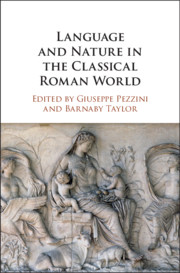Book contents
- Language and Nature in the Classical Roman World
- Language and Nature in the Classical Roman World
- Copyright page
- Contents
- Contributors
- Acknowledgements
- Abbreviations
- Introduction: First Thoughts on Language and Nature
- Chapter 1 Posidonius’ Linguistic Naturalism and Its Philosophical Pedigree
- Chapter 2 Lucilius on Latin Spelling, Grammar, and Usage
- Chapter 3 Nigidius Figulus’ Naturalism
- Chapter 4 Naturalism in Morphology
- Chapter 5 What’s Hecuba to Him?
- Chapter 6 Linguistic Naturalism in Cicero’s Academica
- Chapter 7 Linguistic Naturalism and Natural Style
- Chapter 8 Natural Law and Natural Language in the First Century BCE
- Bibliography
- Index Locorum
- Index Nominum et Rerum
Chapter 4 - Naturalism in Morphology
Varro on Derivation and Inflection
Published online by Cambridge University Press: 05 June 2019
- Language and Nature in the Classical Roman World
- Language and Nature in the Classical Roman World
- Copyright page
- Contents
- Contributors
- Acknowledgements
- Abbreviations
- Introduction: First Thoughts on Language and Nature
- Chapter 1 Posidonius’ Linguistic Naturalism and Its Philosophical Pedigree
- Chapter 2 Lucilius on Latin Spelling, Grammar, and Usage
- Chapter 3 Nigidius Figulus’ Naturalism
- Chapter 4 Naturalism in Morphology
- Chapter 5 What’s Hecuba to Him?
- Chapter 6 Linguistic Naturalism in Cicero’s Academica
- Chapter 7 Linguistic Naturalism and Natural Style
- Chapter 8 Natural Law and Natural Language in the First Century BCE
- Bibliography
- Index Locorum
- Index Nominum et Rerum
Summary
Naturalism is a vague label not only in ancient linguistic thought.1 When modern linguists speak of naturalism, they mean a variety of different things. A phonologist might consider a symmetrical vowel system, with the same number of front and back vowels, more natural than a system with gaps. The reason is that in such a symmetrical system a minimal number of features, vowel height and front versus back, suffices for a given number of vowels. Here, naturalness comes close to the concept of efficiency. A morphologist might consider a system natural in which derivational morphemes stand closer to the lexical root than inflectional morphemes. We move from the most central element of a word, its lexical meaning, to its least central element, the function of the word in a given syntactic context. Here, naturalness is akin to clarity. And finally, an etymologist might consider changes in sounds and meaning natural if the sound changes are based on articulatory or acoustic similarities and if the semantic changes involve concepts such as metaphor. Here, naturalness is related to similarity.
- Type
- Chapter
- Information
- Language and Nature in the Classical Roman World , pp. 103 - 120Publisher: Cambridge University PressPrint publication year: 2019
- 2
- Cited by

